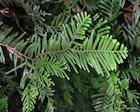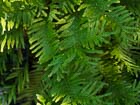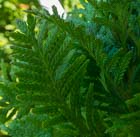
Foliage on a tree in habitat; one of the photos posted on the endemia.nc page for L. yateensis [Daniel & Irène Létocart 2002.04.18].

Foliage on a sapling at the Royal Tasmanian Botanical Gardens [C.J. Earle, 2015.02.25].

Foliage on a sapling at the Royal Tasmanian Botanical Gardens [C.J. Earle, 2015.02.25].

Foliage on a sapling at the Royal Tasmanian Botanical Gardens [C.J. Earle, 2015.02.25].

Foliage on a sapling at the Royal Tasmanian Botanical Gardens [C.J. Earle, 2015.02.25].

Conservation Status

Libocedrus yateensis
Guillaumin 1949
Common names
Taxonomic notes
Syn.: Stegocedrus yateensis (Guillaumin) Doweld 2001. Type: New Caledonia, Riviere Bleue, J. Bernier s.n. Few studies have been performed on Libocedrus, but work to date suggests that the New Caledonian species are all closely related; see Libocedrus for discussion.
Description
Shrubs or trees 2-12 m tall, single or multistemmed, 10-30 cm dbh, with spreading to ascending branches forming crown first conical, becoming bushy and rounded with age. Bark red-brown, rough, scaly, exfoliating in thin longitudinal strips or plates. Twigs on branches opposite to subopposite, frond-like, forming dense sprays. Twigs entirely covered with leaves. Leaves, as on other Libocedrus, of two types, facial and lateral. Facials 1.5-2 mm long, rhombic, imbricate, appressed, keeled near the apiculate apex, with stomata near base. Laterals flattened, 2-5 × 1-2 mm, falcate-lanceolate, partly covering the facials, stomata on underside in a band extending to the apex; leaves olive-green with a glaucous-white stomatal band. Pollen cones terminal, solitary, 5-8 × 2-2.5 mm, bearing 16-24 microsporophylls. Seed cones terminal, developing within one growing season, 9-10 mm long, the spiny free tips of the bracts 10-12 mm long. Seeds 6 mm long with a 6 mm wing (Eckenwalder 2000, Farjon 2010).
Distribution and Ecology
New Caledonia: riparian habitats along the Riviere Bleue, Riviere Yaté, Riviere Ouinné, and at Povila and Roche Ouaieme; at elevations of 150-600 m. It occurs as solitary trees and in small groves, typically on river terraces or river banks amidst shrubs and ferns. Its conservation status is Endangered due to the small number of individuals, small number of populations, exposure to fire, and lack of conservation protection for the central New Caledonian populations (Farjon 2010).
This map shows herbarium records of Libocedrus species native to New Caledonia. Red is L. austrocaledonica, yellow is L. chevalieri, and green is L. yateensis. Click on an icon for further information. Distribution data from GBIF (2020.03.30), edited to remove duplicates.
Zone 9 (cold hardiness limit between -6.6°C and -1.1°C) (Bannister and Neuner 2001).
Remarkable Specimens
No data as of 2023.03.03.
Ethnobotany
There has been no known use by indigenous peoples, no known use in horticulture, and very uncommon in botanical gardens (Farjon 2010).
Observations
Remarks
The epithet refers to Yaté, which is near the location of the type collection.
Citations
Guillaumin, A. 1949. Contribution a la flore de la Nouvelle Calédonie. XCII. Plantes récoltées par J. Bernier (complément). Bulletin du Muséum d'histoire naturelle sér. 2, 21:457.
See also
Association Endemia, a site devoted to New Caledonian species. Has excellent photos, a range map, and other information. In French.
The species account at Threatened Conifers of the World.
Farjon (2005) provides a detailed account, with illustrations.





